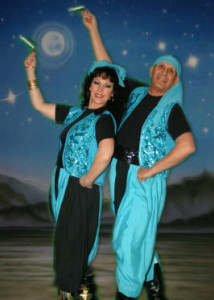
 Debka is a dance that you can find in all countries on the Eastern Mediterranean coast, in the Gulf region and in the areas where the Armenians, Kurds, Persians,
Debka is a dance that you can find in all countries on the Eastern Mediterranean coast, in the Gulf region and in the areas where the Armenians, Kurds, Persians,
Turks and Turkmen live. This type of dance is very well known for its strong character. It has roots in Lebanon, Syria, Jordan, Palestine and Israel. It has a partial influence from the Shoobi dance from Iraq, whose rhythm is Debka rhythm, and from the Debka dance of the Bedouins from Al Ârish on the Egyptian Sinai peninsula.
Some folklore dances from the areas around the Black Sea, Bulgaria, Greece and
Macedonia show elements of the Debka dance. Some Debka steps can also be
found in the dances of the old Babylonian peoples such as the Assurors, for example in Sheykany Folkdance.
DEBKA (also spelled DABKA, DABKIYA or DEBKIYA) is related to the Arabic word Debbek, which means the act of going or walking. Literally it means nothing else but to go and set a foot forward. This act of going, along with the sound produced by a controlled and rhythmic stomping of the feet on the ground, is what attracts people’s attention Debka is often called the dance of the stomping, and this may be the first impression you have when you see this dance. Debka has many different styles; they differ depending on their area, region or country of origin. The step combinations are sometimes soft and flowing like an undulation; the dancers move their shoulders in a
coquettish way, often with small, slow or fast shimmies. The dancers can hold their torso stationary, or they may perform undulations with the dance movements. The dancers may turn their head in all directions or up and down as needed to describe the story that they are telling with their dance. Debka moves can be acrobatic or elegant like figures from ballet (spring, splits, plies), similar to what Cossacks, Armenians, Azerbaijanis and Georgians do. This is more proof of how the different dance styles are connected and how the migrating peoples passed on their traditions to other folk, who then integrated those moves into their own dance.
Lebanese dancers often perform this dance also with two swords or with sticks. The latter is an influence from upper Egyptian Saidi.
Bedouins like to balance a water jar on their head and they have a very fiery way of dancing Debka. Although Debka is danced in different ways in different countries, all the dances have a similar method of combining the steps. The dance usually starts with crossing your left foot in front of your right foot, and the direction of the dance usually moves to the right. The leader, woman or man, is the first in the line and is called RASS, which means ‚head of the line’, or RAYESS ‚leader of the line’. The leader decides which steps and movements the whole line will dance. Generally they wear a hat or a scarf as a symbol of their leading position, while they hold the whole time a plain or rolled scarf in their right hand. They use the scarf to give signs to the rest of the dancers when they want them to change the step combination, to turn in place, to squat, or to scream or sing loudly. The dancer at the end of the line also has a controlling role.
This dancer has to check on homogeneity of the line or circle of dancers. Sometimes the leader turns over the lead position to his/her fellow dancers as they join the line. This turn over process continues until every dancer has been the leader and has shown the group the dance characteristics of the village they are from. Sometimes one dancer will leave the line to show the others a different step combination. During the dance the participants usually shout all together but in a very organized way. Sometimes they will even sing, all together, or just the men or just the women separately. They will keep singing so long and so loud that all the people in the neighborhood will be lured to the festival square. This is always for dancers and spectators a unique experience that makes them feel united and members of the same community. This is especially true for the Lebanese who have many different
creeds (Christians, Druze, Jews and Muslims). The rhythm is usually a 4/4. You can count the music from 1 to 6 or from 1 to 8.
Loud and rhythmic outcries or even whistling are used to keep your breathing constant and continuous. At the same time it gives the dancers a feeling of being a group and sticking together. During festivals in villages, the dancers use the so called scissor step; this kind of step swirls a lot of dust in the air, which attracts people from the surrounding villages (similar to the smoke signals of the Native Americans). The instruments used to play Debka music are different from country to country and even from area to area. The most used instruments though are Rabab (string instrument), drum (tabla), mizmar (simple or double), bagpipes (different kinds) and old wood mortars, used for coffee beans or grain. The latter one is used to produce the dum tak hitting the mortar with a thick wooden stick; there is no sound for the Taks as the stick is being lifted.
References: Mustapha El Oueslati, [email protected], (Spektrum
Orientalischer Tanz bei Nabila Shams El Din (Ulrike Müller) dtd April 2004, Buch
# 10.20.068, nabila-shams-el-din.de
